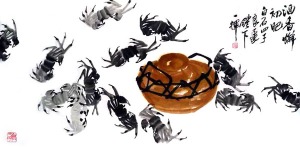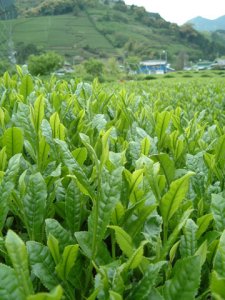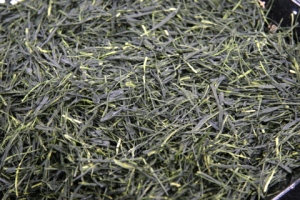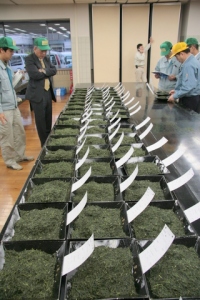It’s the end of October and the fall oolong harvest for tea such as Hairy Crab ( Mao Xie ) is underway in Fujian Province, China. Hairy Crab is a semiball-rolled, modern-style, greenish oolong made in the villages around Anxi in southern Fujian. It is plucked from its namesake tea bush cultivar, and is similar to several in flavor and aroma other oolongs made in this region from their specific tea bush cultivars –Ben Shan, Huang Jin Gui, Tieguanyin and Tou Tian Xiang.
But ask a shopper at a city wet market such as in Shanghai or Hong Kong about the seasonal Hairy Crab and they are likely to point to baskets of fresh crabs that have begun arriving at the market. The season for this seafood delicacy – Eriocher sinensis or mitten crab, known as ‘ Duaza ha’ in the local Shanghai dialect – has just begun, and availability continues until early February. Fall is when the crabs are fattest and the meat is sweetest. Unlike the Hairy crab oolong which is produced in one specific region of small villages, most of these namesake crabs are the product of freshwater aquaculture ( as are many frogs, turtles and eels in China ) in several locations along the Yangtze river in eastern China. Cooking preparations vary, but many believe that simply steaming the crabs and dipping the meat in ginger, vinegar and soy sauce is the best way to enjoy the sweet white flesh. Hairy Crabs are expensive – as much as $26.00 per crab, depending on where they were raised, so tasting the goodness of the crab meat is of paramount importance.
I can only make and educated guess as to why the tea and the crabs share a common name. Pictorially – and in a highly- imaginative kind of way, these army- grey-green, wrinkly little crabs with their oddly constructed bodies, pointy angles and jutting out arms and legs – do bear conceptional similarity to the irregular shape and color of the Hairy Crab tea leaves.
As expected, the fall season is filling the markets with a new infusion of both tea and crabs. Our Hairy Crab oolong is from the 2011 spring season, and is fantastically aromatic and rich in the cup. The fall version of this tea is more full-bodied and less sweet tasting, perhaps a more well-balanced counterpoint to the taste of the cooked crab. Coincidentally, both of these Chinese specialties carry the word ‘sinensis’ ( meaning from China or of China ) in their taxonomic name.










